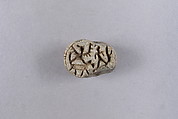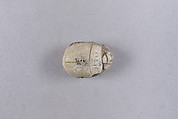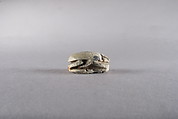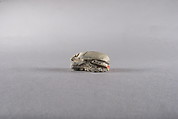Scarab with Representations of Seth-Baal and Reshef
Third Intermediate Period
A particular type of seal-amulet is found in archaeological contexts from the 10th B.C. onwards. They are quite crudely and irregularly carved and the motifs on the underside show predominantly hunting scenes, with varied combinations of horned quadrupeds, lions, ostriches, and hunters. Based on the style of the incisions and on the large numbers that have surfaced in (northern) Egypt, but especially in the southern Levant, these seal-amulets are considered to be the result of a mass production. Their origin, however, is still under discussion. In the scholarly literature, they are labelled ‘Post-Ramesside mass-produced seal-amulets’ and are dated to the late 11th and 10th centuries B.C., that is, Dynasty 21 and early Dynasty 22 in Egypt, or the end of the Iron Age IB – early Iron Age II in the southern Levant.
This scarab shows two figures standing on the backs of animals. One figure stands on a lion; he is winged and wears a high headdress. He is the Levantine storm and fertility god Seth-Baal, who is known from the New Kingdom when Baal was assimilated with the Egyptian god Seth. The second figure stands on an animal with long straight horns (an oryx ?), both arms handing down next to his body. He is Reshef, another Levantine deity, who, like Baal, was introduced in Egypt before the New Kingdom but is prevalent on seal-amulets of the late New Kingdom and early Third Intermediate Period (Dynasty 19–21, ca. 1295-945 B.C.)
Due to rights restrictions, this image cannot be enlarged, viewed at full screen, or downloaded.
This artwork is meant to be viewed from right to left. Scroll left to view more.





